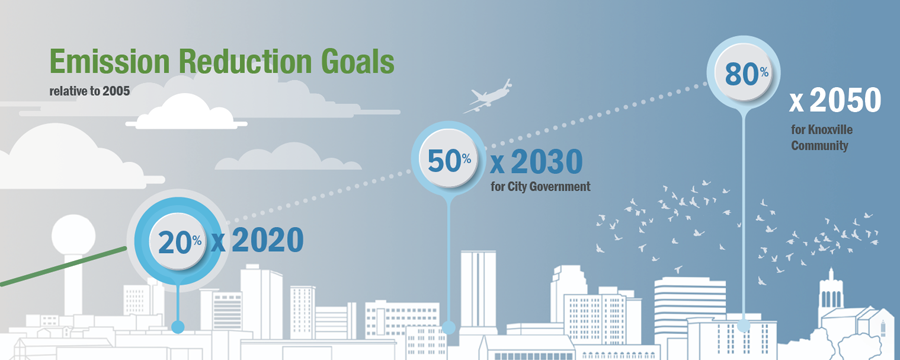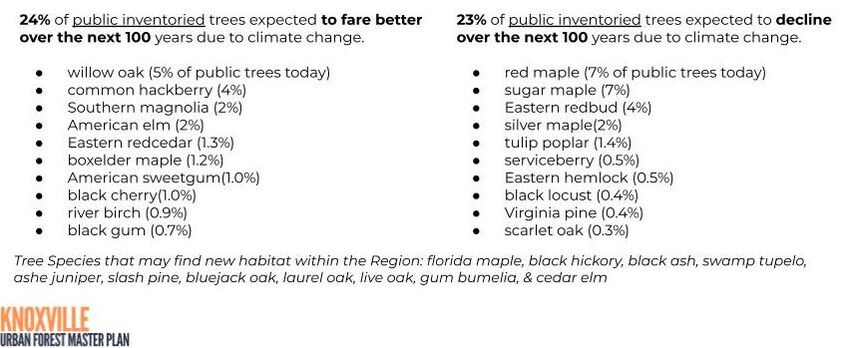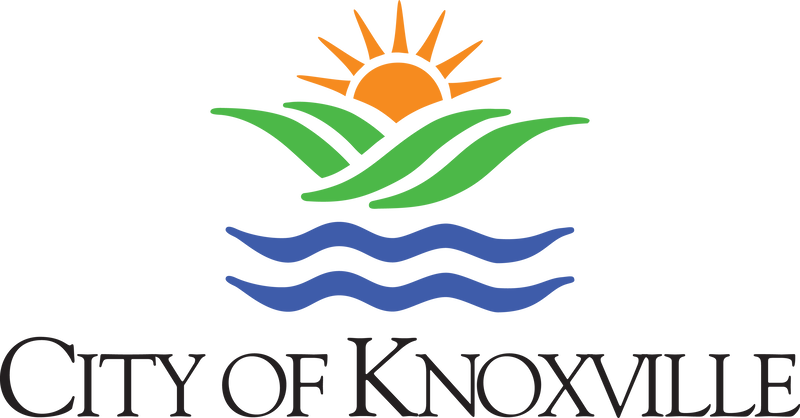Knoxville Trees and Climate Change
In broad terms, there are two parts to dealing with climate change: 1) slowing climate change itself, and 2) working to adapt to climate changes already here. Trees are keys aspects of of both efforts. Learn more here about dealing with climate change and the roles trees play in those efforts, then take a look at the expected impact of climate change on Knoxville's trees themselves.
1. Slowing Climate Change Overall (also called "mitigation")
These are efforts to reduce the cause of climate change to slow or stop the effect altogether. This is called "mitigation," and is most commonly undertaken through efforts of communities to reduce greenhouse gas emissions over time.
Knoxville has emission reduction goals in place (see below right). It is also important to note that trees absorb carbon in the atmosphere every single day through the process of photosynthesis. They take in carbon in the air through the leaves, make sugars for food, and emit oxygen back into the air. This process of taking carbon out of the air is called "carbon sequestration." Trees also store carbon over their lifetimes in their tissues (wood). If that tree is taken down and chipped up or burned, that carbon is released.
Knoxville has emission reduction goals in place (see below right). It is also important to note that trees absorb carbon in the atmosphere every single day through the process of photosynthesis. They take in carbon in the air through the leaves, make sugars for food, and emit oxygen back into the air. This process of taking carbon out of the air is called "carbon sequestration." Trees also store carbon over their lifetimes in their tissues (wood). If that tree is taken down and chipped up or burned, that carbon is released.
|
Take a look at what the existing trees in Knoxville do already today: Figures taken from 2021 Urban Tree Canopy Assessment Knox County and City of Knoxville Report. COUNTYWIDE (Knox County)
CITYWIDE (City of Knoxville)
This all means that any losses in tree canopy will have an effect the amount of greenhouse gases in the air, and contribute to the increase in speed and severity of climate change in Knoxville. |
City of Knoxville's "Mitigation" Efforts
Excerpt and chart from City of Knoxville website page on Climate Change: Climate change is real and intensifying many challenges we already face in Knoxville, like extreme heat, extreme storms, flash flooding, air pollution, and pests. Reducing Knoxville’s emissions footprint is crucial to combating climate change, improving our ability to bounce back from disasters, protecting our health, and being smart with taxpayer dollars. |
2. Adapting to Existing Climate Change Efforts (also called "adaptation")
|
The second piece of dealing with climate change is figuring out ways to adapt and adjust to its effects (high heat levels, severe storms, flooding, drought) already here. This includes finding ways to lessen the impacts on humans and ecosystems in general.
Trees are a significant part of this work, considered by many as one of the most effective and cost efficient ways for dealing with heat and heat stress in communities. Urban trees are widely accepted as one of the most effective long-term solutions to reducing the effects of urban heat islands. Properly placed mature tree canopy can lower overall ambient temperatures by 20° to 45°F (EPA 2015). Human mortality (death) from heat stress related issues kills more Americans each year than any other natural disaster. Learn more about the role trees play here. |
Urban trees are widely accepted as one of the most effective long-term solutions to reducing the effects of urban heat islands. |
Impact of Climate Change on Knoxville Trees
|
While tree canopy is a key piece of climate change resilient, they themselves are not immune from the effects of climate change. They can suffer from the effects of climate change - warming temperatures, changes to precipitation, increases in threats from pests and diseases - can mean that trees currently thriving in Knoxville may not thrive in 100 years.
The USDA Climate Atlas tool is a model that can be used to predict which trees may be impacted by the effects of climate change. While some species are predicted to face declines throughout the Knoxville area (including 23% of Knoxville's current street tree population), other trees are anticipated to fare better over the next 100 years. Additional, new species may even move into this area. Check out the chart to the right for the full list of predicted changes to Knoxville's trees (click on the image for a larger, more readable table). How Climate Changes Will Impact Knoxville Public Trees |









